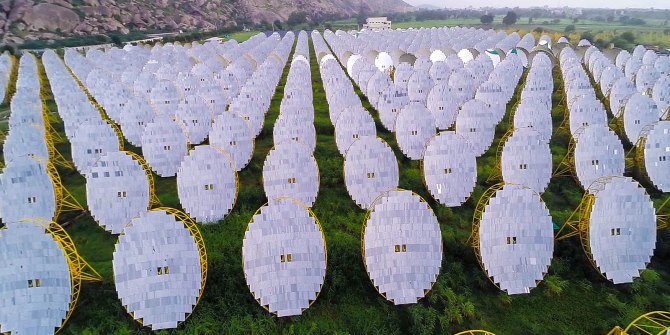 In order to meet its ambitious solar targets India has sought to boost local production of solar cells. However, Pritish Behuria highlights how it has come up against problems, as America, the WTO and others have restricted the country’s ability to develop its domestic manufacturing capabilities. He writes that if solar cell production is to survive in India, much more government action will need to be taken.
In order to meet its ambitious solar targets India has sought to boost local production of solar cells. However, Pritish Behuria highlights how it has come up against problems, as America, the WTO and others have restricted the country’s ability to develop its domestic manufacturing capabilities. He writes that if solar cell production is to survive in India, much more government action will need to be taken.
Last month, the World Trade Organisation (WTO) ruled against India’s efforts to boost local production of solar cells, which was a key component of the Jawaharlal Nehru National Solar Mission (JNNSM). The JNNSM aimed to “promote ecologically sustainable growth while addressing India’s energy security challenge” and constituted “a major contribution by India to the global effort to meet the challenges of climate change.” The American government had indicated public support for this mission. However, since February 2013, it had been kicking away the ladder by blocking any Indian attempts to build domestic manufacturing capabilities in the sector. There is an all-too-familiar story of hypocrisy here. One BBC article claimed that the United States did not practice what it preached at home and “half of all US states have subsidies for renewables.” The JNNSM was a way for the Indian government to address its domestic energy deficit and would have helped India achieve its pledge of developing 40 per cent of its renewables by 2030. Though the expansion of India’s solar energy sector will continue, priorities including acquiring technological capabilities among domestic producers and reducing dependency on foreign technology have taken a backseat.
The JNNSM was launched in 2010 by the Manmohan Singh government. Its initial target was achieving an ambitious target of 22 GW by 2022. The mission adopted a 3-phase approach. Phase 1 concluded in 2013, with the Indian government successfully increasing installed solar energy capacity from 30 MW to 2000 MW. By 2014, the Narendra Modi government has raised targets by 75 per cent by setting the goal of achieving national installed capacity of 15 GW by 2017. By 2016, the government has already secured installed capacity of 5.7GW. Modi also made ambitious plans of reaching 100 GW of installed capacity by 2022 (more than four times the goal set by the Manmohan Singh government). No country has ever expanded its installed solar energy capacity to this extent before. China’s solar capacity stands at around 40GW. If targets are met, India will become the biggest solar country in the world.

These ambitions have drawn the attention of the business community in India, with several new entrants in the sector. Modi has also spearheaded the establishment of The Global Solar Alliance, which includes participation from 120 countries and industry representatives. As part of the alliance, Bill Gates, Mukesh Ambani, Jack Ma and other investors have backed the establishment of a Breakthrough Energy Coalition, which will act as a vehicle for investing in clean energy projects. Within India, this project is perceived to be a top priority for Modi. He has also received acclaim for previous success in the sector, having supported the establishment of Asia’s largest solar park in Gujarat – The Chankara Solar Park.
Despite the euphoria around the solar energy sector in India, there have been significant problems with regard to the speed of market-led reforms and open bidding that has been a feature of the sector’s expansion. The government has had very little emphasis on building reciprocal control mechanisms with the private sector or managing rents effectively. The latter will be at the heart of successful green industrial policy, according to Hubert Schmitz. Some leading players have already run into problems. SunEdison – a company, which was among the leading investors during initial phases of the JNNSM – has collapsed and filed for bankruptcy protection in the United States. State utilities may not be able to meet the capabilities that are necessary to accompany the expansion of the solar energy sector. All state utilities will need a mix of conventional generators with different levels of flexibility to balance between electricity supply and demand on the grid. However, all states do not have access to the required resources in the right measure. It is also unclear whether new entrants in the sector, which have won bids on new solar parks and facilities, will be able to deliver their promises. It is also unlikely that the government will be able to retain the capacity to discipline and monitor such actors as part of the fast-paced expansion. Storage is also a significant problem since solar power can only be generated during the day. However, the government is including energy storage as requirements as part of some tenders.
A significant weakness of this strategy is the inadequate support that the government has given to local manufacturers to acquire technology in the sector. China, Korea and Taiwan – latecomers in the sector – all used much more aggressive policies (including subsidies) to promote technology acquisition. If the strategy proceeds in the way it has, there is a danger that dependency on foreign actors will be built into the domestic value-chain for solar energy. It is already claimed that India suffered from being a new entrant in the sector and technology development was comparatively low. In 2012, Indian solar cell manufacturers – IndoSolar Limited, Jupiter Solar Limited and Websol Energy Systems Ltd – wrote to the Commerce ministry that four countries – the US, China, Taiwan and Malaysia – were dumping solar cells on the Indian market. These companies claimed foreign imports assumed 60 per cent of the market. Following a lengthy investigation, the Commerce Ministry proposed to the Finance Ministry that restrictive anti-dumping duties in the range of $0.11-$0.81/watt be imposed on imported solar cells. However, the Finance Ministry took no action. In 2015, Indian manufacturers had chosen to approach both the Commerce Ministry and the Finance Ministry once again, arguing that imports now controlled more than 90 per cent of the market. Though the government has promised local firms that it will take some action and even threatened the US with filing 16 cases for violation of WTO treaties, there has been very little action. At this stage, the manufacturing sector remains extremely fragmented and lacking vertical integration. Forty per cent of solar cell manufacturers have closed down by 2015 and overall industry capitalisation was 21 per cent. Thus, at this stage, the solar energy segment of Modi’s Make in India appears to be floundering.
The expansion of India’s solar energy is promising. One infrastructural landmark was the establishment of the world’s first solar-powered airport in Cochin. In January 2016, India’s Energy Minister claimed that solar tariffs were now cheaper than those of coal-fired generation. Solar projects were also continuing to attract bids of less than five rupees per unit, including those of ReNew Power in Telangana, Azure Power, Parampujya Power and Acme Solar. Discussion of the potential of solar energy is flourishing in India’s national daily newspapers, with regular announcements of new projects across the country. However, growth in the sector must be matched with the acquisition of technological capabilities among domestic manufacturers if long-term dependency on foreign actors is to be avoided. Though India plans to appeal the WTO ruling in the coming months, much more government action will need to be taken if domestic solar cell manufacturing is to survive in India.
Note: This article gives the views of the author, and not the position of the South Asia @ LSE blog, nor of the London School of Economics. Please read our comments policy before posting.
About the Author
 Dr Pritish Behuria is an LSE Fellow in International Development at the London School of Economics and Political Science. Follow him on Twitter @PritishBehuria.
Dr Pritish Behuria is an LSE Fellow in International Development at the London School of Economics and Political Science. Follow him on Twitter @PritishBehuria.







